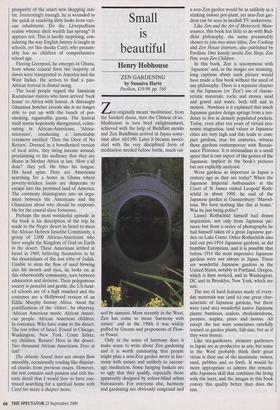Small is beautiful
Henry Hobhouse
ZEN GARDENING by Sunniva Harte Pavilion, £19.99, pp. 160 Zen originally meant 'meditation', from the Sanskrit dyana, then the Chinese ch'an. Meditation in turn bred enlightenment, achieved with the help of Buddhist monks and Zen Buddhism arrived in Japan some- time after AD1100. Later it became associ- ated with the very disciplined form of meditation needed before battle, much val- ued by samurai. More recently in the West, Zen has come to mean 'harmony with nature' and in the 1960s it was widely puffed by Greens and proponents of Flow- er Power.
Only in the sense of harmony does it make sense to write about Zen gardening and it is worth ruminating that people might plan a non-Zen garden never in har- mony with nature and unlikely to encour- age meditation. Some hanging baskets are so ugly that they qualify, especially those apparently designed by colour-blind urban bureaucrats. For everyone else, harmony and gardening are obviously congenial and a non-Zen garden would be as unlikely as a stinking indoor pot-plant, yet non-Zen gar- dens can be seen in modish TV makeovers.
Like Zen and the Art of Motorcycle Main- tenance, this book has little to do with Bud- dhist philosophy, the name presumably chosen to join two sister titles, Zen Cooking and Zen House Interiors, also published by Pavilion. One keenly awaits Zen Sleep, Zen Pets, even Zen Children.
In this book, Zen is synonymous with `Japanese' and, as the images are stunning, long captions about each picture would have made a fine book without the need of any philosophy. There is a separate chapter on the Japanese (or 'Zen') use of charac- teristic materials: rocks and stones, sand and gravel and water, both still and in motion. Nowhere is it explained that much Japanese garden design springs from a ten- dency to live in densely populated pockets. Today, even after ten years of virtual eco- nomic stagnation, land values iti Japanese cities are very high and this leads to com- pact gardens, true for centuries, witness those gardens contemporary with Renais- sance Florence. It is minimalism in a small space that is one aspect of the genius of the Japanese, implicit in the book's pictures but not explicitly analysed.
Were gardens as important in Japan a century ago as they are today? When the Japanese Imperial Ambassador at the Court of St James visited Leopold Roth- schild in about 1905, he said of the Japanese garden at Gunnersbuty: 'Marvel- lous. We have nothing like this at home.' Was he just being polite?
Lionel Rothschild himself had drawn inspiration, not only from Japanese pic- tures, but from a series of photographs he had himself taken of a great Japanese gar- den on Lake Como. Other Rothschilds also laid out pre-1914 Japanese gardens, as did humbler Europeans, and it is possible that before 1914 the most impressive Japanese gardens were not always in Japan. There are wonderful Japanese gardens in the United States, notably in Portland, Oregon, which is here noticed, and in Washington, DC and in Brooklyn, New York, which are not.
The use of hard features made of every- day materials was (and is) one great char- acteristic of Japanese gardens, but there were (and are) wonderful native Japanese plants: bamboos, azaleas, rhododendrons, peonies, maples, pines and hostas. All except the last were sometimes carefully trained as garden plants, full-size, but as if they were bonsai.
Like tea-gardeners, pleasure gardeners in Japan are as productive as any, but some in the West probably think their great virtue is their use of the inanimate: stones, sand, pebbles and so forth. It would be more appropriate to admire the remark- able Japanese skill that combines the living with the inert, and the images in this book convey this quality better than does the text.






















































































 Previous page
Previous page